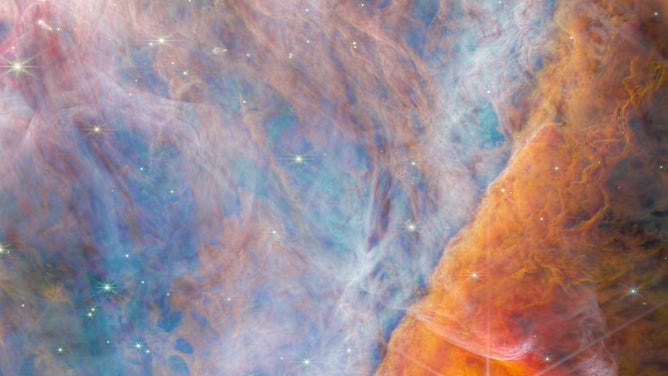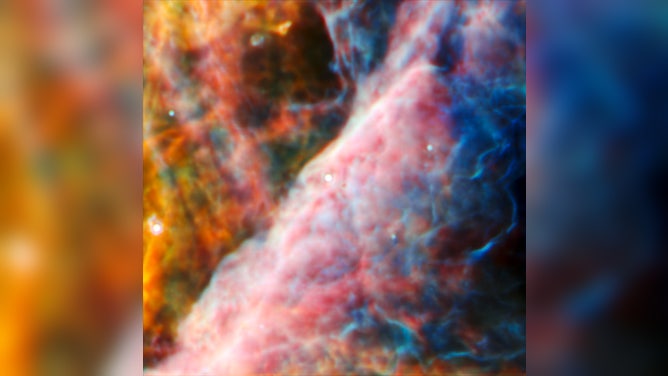Building blocks for life found in space by NASA’s James Webb Space Telescope
Methyl cation was found in a young star system with the protoplanetary disk d203-506, located about 1,350 light-years away in the Orion Nebula.
See stunning images taken by the James Webb Space Telescope
The James Webb Space Telescope has released mesmerizing images of the deepest corners of our universe.
NASA announced on Monday that a new carbon compound had been found in space for the first time. The discovery is of particular note as carbon compounds form the foundations of all known life.
Known as methyl cation, this molecule has a unique property, according to the European Space Agency.
While methyl cation reacts relatively inefficiently with hydrogen, the most abundant element in the universe, the ESA said the carbon compound reacts readily with other molecules. This helps initiate the growth of more complex carbon-based molecules.
Methyl cation was found in a young star system with the planet-forming disk d203-506, located about 1,350 light-years away in the Orion Nebula.

These Webb images show a part of the Orion Nebula known as the Orion Bar. The largest image, on the left, is from Webb’s NIRCam (Near-Infrared Camera) instrument. At upper right, the telescope is focused on a smaller area using Webb’s MIRI (Mid-Infrared Instrument). At the very center of the MIRI area is a young star system with a protoplanetary disk named d203-506. The pullout at the bottom right displays a combined NIRCam and MIRI image of this young system.
(ESA/Webb, NASA, CSA, M. Zamani (ESA/Webb), and the PDRs4All ERS Team / NASA)
The discovery of methyl cation in such an environment might seem surprising, however, according to NASA.
The star system d203-506 is bombarded with UV radiation from nearby stars that are hot, young and massive. This UV radiation would typically destroy complex organic – or carbon-containing – molecules, such as methyl cation. And yet, methyl cation molecules are able to exist within d203-506.
Additionally, rather than destroy the carbon compound, UV radiation might provide the necessary energy source for the formation of methyl cation. The UV radiation might also promote additional chemical reactions to build more complex carbon molecules, according to the international team of scientists behind the discovery.

This image taken by Webb’s NIRCam (Near-Infrared Camera) shows a part of the Orion Nebula known as the Orion Bar. It is a region where energetic ultraviolet light from the Trapezium Cluster — located off the upper-left corner — interacts with dense molecular clouds.
(ESA/Webb, NASA, CSA, M. Zamani (ESA/Webb), and the PDRs4All ERS Team / NASA)
Another curious aspect of the discovery is that the molecules found in d203-506 are quite different from typical protoplanetary disks, in that no signs of water could be detected.
"This clearly shows that ultraviolet radiation can completely change the chemistry of a protoplanetary disk," elaborated Olivier Berné of the French National Centre for Scientific Research in Toulouse, lead author of the study.
"It might actually play a critical role in the early chemical stages of the origins of life," Berné added.

This image from Webb’s MIRI (Mid-Infrared Instrument) shows a small region of the Orion Nebula. At the center of this view is a young star system with a protoplanetary disk named d203-506.
(ESA/Webb, NASA, CSA, M. Zamani (ESA/Webb), and the PDRs4All ERS Team / NASA)
Berné and his team made the discovery by using NASA’s James Webb Space Telescope. NASA said the telescope detected a series of key emission lines from methyl cation in the region, which cemented the discovery of the carbon compound.
"This detection not only validates the incredible sensitivity of Webb but also confirms the postulated central importance of CH3+ in interstellar chemistry," said Marie-Aline Martin-Drumel of the University of Paris-Saclay in France, a member of the science team.
According to NASA, carbon compounds are of particular interest to scientists working to understand how life developed on Earth and how it could potentially develop elsewhere in our universe.
